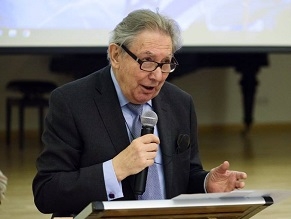|
Analytics

Prof. Antony Polonsky
|
Antony Polonsky: “I Have Grave Doubts about How Khrzhanovsky’s Proposal Will Work in Practice"
06.05.2020, Communities of Eurasia Given the large number of monuments at Babyn Yar and the incoherent message they convey, it is clearly highly desirable for a comprehensive plan to be drawn up for the site. As is well known, there have been a number of separate proposals. I was sent some time ago the proposal for a Babyn Yar Holocaust Memorial Centre and its Basic Historical Narrative by the then Chairman of its scholarly committee, Karel Berkhoff. This was a serious and well thought-out proposal and I liked it very much.
I have now reviewed the PowerPoint presentation of a draft proposal of the Baby Yar Holocaust Memorial Centre in which the key role is played by the film-maker Ilya Krzhanovsky, who has been appointed its artistic director. I have serious reservations about this proposal: It does not provide a clear historical narrative and has too much extraneous material, above all in its discussion of the Stanford Prison Experiment, which was supposed to illustrate how well-meaning individuals can be induced to take part in the abuse of prisoners and which will, in the eyes of its creators, illustrate the dilemma posed by Nazi mass murder to "bystanders." This is linked with the proposal that visitors, on the basis of a questionnaire, be confronted with ethical choices and identify as either a victim, a Nazi soldier, or a local collaborator. I have grave doubts about how this will work in practice and do not believe that the proposal is appropriate for a memorial on the Babyn Yar site.
Role-playing of this sort is discouraged by most prominent Holocaust Museums. There is certainly a place for the comparison of the Holocaust with other genocides and cases of mass killing. It is also important to create empathy with the victims and an understanding of the sources of the genocidal mentality. However, I do have reservations about the approach advocated in the new proposal, which seems to me to rely too much on shock tactics.
I very much favor a more historical approach, as was proposed by the earlier Basic Historical Narrative. This is in accordance with the practice adopted in other memorial sites, such as those at the former concentration camps of Auschwitz, Treblinka, and Belsen, to mention only three. I hope that it will be possible to resuscitate this earlier proposal.
For accounts of the problems of the construction of appropriate monuments, I would refer the interested reader to James Young's The Texture of Memory: Holocaust Memorials and Meaning (Yale University Press, 1993) and John Huener's Auschwitz, Poland, and the Politics of Commemoration, 1945-1979 (Ohio University Press, 2003).
By Antony Polonsky
About the Author
Krytyka
|
|
